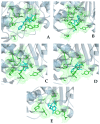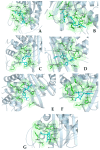From Antiretroviral to Antibacterial: Deep-Learning-Accelerated Repurposing and In Vitro Validation of Efavirenz Against Gram-Positive Bacteria
- PMID: 40733192
- PMCID: PMC12299921
- DOI: 10.3390/molecules30142925
From Antiretroviral to Antibacterial: Deep-Learning-Accelerated Repurposing and In Vitro Validation of Efavirenz Against Gram-Positive Bacteria
Abstract
The repurposing potential of Efavirenz (EFV), a clinically established non-nucleoside reverse transcriptase inhibitor, was comprehensively evaluated for its in vitro antibacterial effect either alone or in combination with other antibacterial agents on several Gram-positive clinical strains showing different antibiotic resistance profiles. The binding potential assessed by an in silico study included Penicillin-binding proteins (PBPs) and WalK membrane kinase. Despite the relatively high minimum inhibitory concentration (MIC) limiting the use of EFV as a single antibacterial agent, it exhibits significant synergistic activity at sub-MIC levels when paired with various antibiotics against Enterococcus species and Staphylococcus aureus. EFV showed restored sensitivity of β-lactams against Methicillin-resistant S. aureus (MRSA). It increased the effectiveness of antibiotics tested against Methicillin-sensitive S. aureus (MSSA). It also helped to overcome the intrinsic resistance barrier for several antibiotics in Enterococcus spp. In silico binding studies aligned remarkably with experimental antimicrobial testing results and highlighted the potential of EFV to direct the engagement of PBPs with moderate to strong binding affinities (pKa 5.2-6.1). The dual-site PBP2 binding mechanism emerged as a novel inhibition strategy, potentially circumventing resistance mutations. Special attention should be paid to WalK binding predictions (pKa = 4.94), referring to the potential of EFV to interfere with essential regulatory pathways controlling cell wall metabolism and virulence factor expression. These findings, in general, suggest the possibility of EFV as a promising lead for the development of new antibacterial agents.
Keywords: Efavirenz; antibacterial activity; drug repurposing; in silico binding study.
Conflict of interest statement
The authors declare no conflicts of interest.
Figures











Similar articles
-
Efavirenz or nevirapine in three-drug combination therapy with two nucleoside or nucleotide-reverse transcriptase inhibitors for initial treatment of HIV infection in antiretroviral-naïve individuals.Cochrane Database Syst Rev. 2016 Dec 10;12(12):CD004246. doi: 10.1002/14651858.CD004246.pub4. Cochrane Database Syst Rev. 2016. PMID: 27943261 Free PMC article.
-
Identification of an antibiotic from an HTS targeting EF-Tu:tRNA interaction: a prospective topical treatment for MRSA skin infections.Appl Environ Microbiol. 2025 Jan 31;91(1):e0204624. doi: 10.1128/aem.02046-24. Epub 2024 Dec 23. Appl Environ Microbiol. 2025. PMID: 39714192 Free PMC article.
-
Bacteriophage infection drives loss of β-lactam resistance in methicillin-resistant Staphylococcus aureus.Elife. 2025 Jul 10;13:RP102743. doi: 10.7554/eLife.102743. Elife. 2025. PMID: 40637714 Free PMC article.
-
Biological activities of optimized biosynthesized selenium nanoparticles using Proteus mirabilis PQ350419 alone or combined with chitosan and ampicillin against common multidrug-resistant bacteria.Microb Cell Fact. 2025 Jul 5;24(1):159. doi: 10.1186/s12934-025-02783-0. Microb Cell Fact. 2025. PMID: 40618114 Free PMC article.
-
Abacavir-based triple nucleoside regimens for maintenance therapy in patients with HIV.Cochrane Database Syst Rev. 2013 Jun 5;2013(6):CD008270. doi: 10.1002/14651858.CD008270.pub2. Cochrane Database Syst Rev. 2013. PMID: 23740608 Free PMC article.
References
-
- World Health Organization . 2019 Antibacterial Agents in Clinical Development: An Analysis of the Antibacterial Clinical Development Pipeline. World Health Organization; Geneva, Switzerland: 2020.
MeSH terms
Substances
LinkOut - more resources
Full Text Sources
Medical
Miscellaneous

